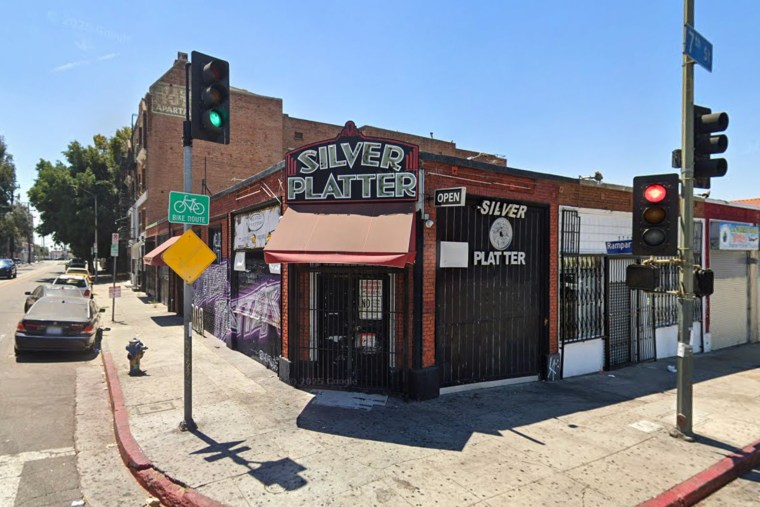For decades, the Silver Platter bar has been a haven for Latino and LGBTQ people in the Los Angeles area, attracting a cross-border clientele looking for a place where they can fully be themselves. Now that haven is at imminent risk of demolition amid plans to develop the site.
“This bar is historic,” owner Margarita Xatruch said about the space, which was built in the 1920s and has been open as a bar since 1963 and the subject of a documentary. “Everyone knows it, everyone knows they can come here to celebrate. And it’s very important so that we can continue the Latin legacy we have here,” she added, sitting in one of the red vinyl chairs that decorate the space, which is also famous in the Westlake neighborhood for its neon sign.
Silver Platter is one of 13 sites that the Latinos in Heritage Conservation group is putting forth in a first-of-its-kind list published Tuesday, spotlighting sites of Hispanic heritage it deems worthy of preservation but that are likely to disappear.
The list highlights places with a history ranging from centuries back through recent decades.
It includes the Elgin cemetery in Texas, an early 20th century burial ground for Mexican Americans from when segregation was the norm; the historic Sacred Heart of the Church of Jesus in Ruidosa, Texas, which is made of adobe, the Barrio Chihuahita historic neighborhood in Tucson, Arizona, established in 1848 and Las Barracas in Longmont, Colorado, a former military barrack repurposed to house Mexican migrant farmworkers and a “rare surviving example of agricultural labor housing,” according to Latinos in Heritage Conservation.
The list also calls for the preservation of art pieces such as the Our Lady of Guadalupe Vietnam Veterans’ Memorial Mural in Chicago, one of the oldest standing murals dedicated to veterans of that war, as well as other murals by artists of Latino descent in San Francisco’s Mission District, next to an Oakland freeway and one dating from 1930 advocating racial unity in Washington, D.C.
“We really wanted to create a program or a campaign that would be proactive in helping to save these sites, to tell their stories and promote the preservation of these sites,” conservationist Sehila Mota Casper, director of the group behind the initiative, said in an interview. She said factors such as climate, gentrification and demolition are already impacting or may soon impact these sites.
Mota Casper said they hope the campaign can garner a positive response from public policymakers, following the success in recent years in preserving sites of historical significance to Black and Asian American communities, such as portions of the Underground Railroad and some of the internment camps where Japanese Americans were held by the U.S. government in the 1940s.
The team behind the Silver Platter bar hopes that its inclusion on this list can help it at least reopen elsewhere, said Andrew Salimian, advocacy director at the LA Conservancy, who nominated the site.

Martha Vásquez, the daughter of Xatruch, the Silver Platter’s owner, said “that instability, economically, politically, locally, is very stressful. We’re fighting to see if we can find another location.”
Latinos in Heritage Conservation says it’s key to raising awareness about the dangers of history fading away without getting recognition. According to its 2024 analysis of the National Park Service’s National Register of Historic Places, less than 1% are linked to Latino history.
It’s a number that Mota Casper believes undermines the richness of Latino contributions to the country, especially in the Southwest, which was once part of Mexico and where different groups have long sought to leave a mark that highlights elements of a cross-border identity.
“There are many chapters missing in the books of American history,” the preservationist notes. She said the same types of protections given to architectural styles or to historic houses, including plantations, need to be placed on locations of Latino heritage. “Without that type of protection, we will lose sites,” she said.
Mota Casper says that when she mentions to people what her job is, they always ask her about the Alamo. But there’s a rich history of other sites that are important to Latino communities, yet many people are unaware of them, which is one of the drives behind unveiling the list.
The list is also coming out as recent efforts to recognize historic contributions of Latinos are being reversed. The Trump administration ordered in July that Fort Cavazos, a military base renamed in 2023 in honor of the first Hispanic four-star general and brigadier general, Richard Cavazos, revert back to its former name of Fort Hood, named after a Confederate general, John Bell Hood, and now honoring a World War I colonel, Robert B. Hood.
The efforts from Latinos in Heritage Conservation have the support of some local and federal legislators, such as Los Angeles Councilmember Eunisses Hernández and Rep. Joaquin Castro, D-Texas, who for several years has pushed for the inclusion of more Latino representation in the national film and music recording registries.


